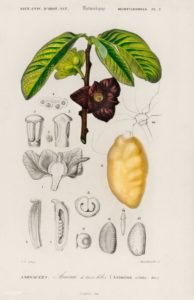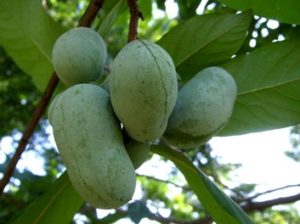
“Asimina triloba” by Free Public Domain Illustrations by rawpixel, CC BY 2.0.
Our September Plant of the Month is pawpaw (Asimina triloba) because it is currently pawpaw season! Pawpaw is a perennial shrub or tree whose large fruit ripens between the months of August and October. It belongs to the Custard Apple Family (Annonaceae) and is often compared to a papaya with a mellow banana taste. The name pawpaw is derived from the name papaya, although it is also known by names such as “false banana” or “pawpaw apple.” Despite its tropical appearance and taste, pawpaw is in fact native to Eastern North America and therefore also North America’s largest native fruit. You should not be surprised to come upon it locally in Knoxville and the surrounding areas!
The shrub or tree can grow anywhere between 10 and 40 feet tall. Its large pear-shaped leaves have a scent similar to a bell pepper and will turn yellow before dropping in the fall. The twigs and leaves also contain insecticidal properties that keep it pest resistant. The flowers bloom around April/May and change from green to purple/maroon with six petals that curl slightly backwards. The pawpaw fruit has thin yellowish-green to brown skin, is cylindrical, and grows alone or in groups of two or four; they can grow to be 3 to 7 inches long. The fruit typically softens when ripe, falling from the tree. You can also shake them from the tree before they are mature, and take them home and wait for them to ripen. You’ll know they are ready when the fruit is soft and very fragrant. The fruit’s custard-like pulp can be either yellow and flavorful or whitish-green and less flavorful, but either is very nutritious and rich in amino acids. Within this pulp are flat seeds that are nearly an inch long (about 2 cm). At archaeological sites, seeds that are not eaten and have been carbonized by fire are most commonly found preserved.

“PawPaws – the Missouri Fruit” by MUExtension417, CC BY-NC 2.0.
Native American tribes such as the Cherokees and the Iroquois not only used pawpaw but cultivated and expanded its distribution range to its current extent. The Cherokees included the pawpaw fruit within their diets and used fiber cordage from the inner bark to make strong ropes and string. The Iroquois also cultivated the pawpaw for food. Given its short shelf life, the fruit was mashed into small cakes, dried in the sun or over fire, and stored for later use. The dried cakes would be taken on hunts or soaked in water and used to create a sauce that would be eaten with corn bread.
George Washington’s favorite dessert to eat is rumored to have been chilled pawpaw fruit, although this is historically undocumented. It is, however, documented that pawpaw was grown at Mount Vernon and mentioned in George Washington’s writings. Colonists adopted many Native American foods into their own diets, so it is not a stretch to believe that George Washington enjoyed this tasty fruit as well.

“Cluster of pawpaw fruit” by Wendell Smith, CC BY 2.0.
To find pawpaws in our community, look for shady open wooded areas, especially along riverbanks. Pawpaws prefer either wet bottomland or rich upland soils. If you plan to forage, make sure to do so responsibly! Always check with a park ranger or property owner first. Pawpaw can also often be found at your local farmers’ markets for purchase. Want to make your own pawpaw creations? Resources such as The Pocket Pawpaw Cookbook by Sara Bir will provide you with further information on how to forage, store, and create your own pawpaw delights such as pawpaw pudding and even banana-pawpaw ketchup!
For More Information:
- Bir, Sara. 2021. The Pocket Pawpaw Cookbook. Belt Publishing. Cleveland, Ohio.
- Hamel, Paul B., and Mary U. Chiltoskey. 1975. Cherokee Plants and Their Uses – A 400 Year History. Herald Publishing, Sylva, North Carolina.
- Moerman, Daniel E. 1998. Native American Ethnobotany. Timber Press, Portland, Oregon.
- US Department of Agriculture, Natural Resources Conservation Service. 2021. PLANTS Database. Electronic document, https://plants.usda.gov/home.
- Wells, E., & Rebecca Louise Brown. 2000. An Annotated Checklist of the Vascular Plants in the Forest at Historic Mount Vernon, Virginia: A Legacy from the Past. Castanea 65(4):242-257.